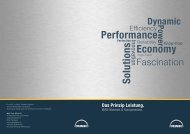Download - MAN Engines
Download - MAN Engines
Download - MAN Engines
Create successful ePaper yourself
Turn your PDF publications into a flip-book with our unique Google optimized e-Paper software.
Press release<br />
<strong>MAN</strong> Nutzfahrzeuge Gruppe, <strong>Engines</strong> and Components______________________________________________________ 4<br />
<strong>MAN</strong> engines and their innovative technology<br />
Common-rail injection system<br />
<strong>MAN</strong> uses the common-rail injection system throughout its range of engines for<br />
mobile machinery. <strong>MAN</strong> was the first engine manufacturer to introduce this<br />
technology and has been using it successfully for many years. The targeted<br />
direct fuel injection under high pressure reduces the exhaust-gas emissions and<br />
has a positive effect on the fuel consumption too. In the common-rail system<br />
every injection nozzle has the same pressure potential thanks to the common<br />
rail (fuel distributor). Targeted atomisation of the fuel through the<br />
electromagnetically actuated eight-hole nozzles is achieved in the injection<br />
process. As the injection pressure is built up independently of the load and the<br />
engine speed, a freely selectable common-rail system pressure can be provided<br />
over the engine's entire operating range. Even at low speeds optimum injection<br />
with practically ideal atomisation under a high injection pressure is possible.<br />
The injection timing and duration are determined by the EDC control unit via<br />
electrically triggered solenoid valves according to the machinery's operating<br />
mode. For this the machinery's power and speed requirements for the engine<br />
are set via the CAN control system. The injection quantity is split into a pilot and<br />
a main injection, by which a more favourable rise in the combustion pressure is<br />
achieved. This multiple injection makes for a much softer combustion. This<br />
results in a further advantage: noise emissions are significantly reduced,<br />
particularly during idling and under partial load. However, the decisive<br />
advantage of common-rail injection is that the system pressure, injection time<br />
and injection quantity can be ideally matched to the engine's operating mode at<br />
any time. High injection pressures at low engine speeds permit a high torque<br />
with low smoke values, while low injection pressures under partial load lead to<br />
optimised NOx values and optimum fuel consumption. At full load high injection<br />
pressures allow high exhaust-gas recirculation rates and low particulate<br />
emissions while the fuel consumption remains favourable.<br />
Two-stage turbocharging with external exhaust-gas recirculation (EGR)<br />
Two-stage turbocharging makes it possible to achieve low emissions without<br />
any loss of power. For this the thermal energy in the exhaust gas is used in the<br />
turbochargers to drive the turbines. At low speeds the first (high-pressure) stage<br />
receives 100 % of the exhaust gas, which increases the volumetric efficiency in<br />
the cylinders and leads to a very fast torque increase. At higher engine speeds<br />
some of the exhaust gas is conducted past the high-pressure turbine via a<br />
waste gate, which increases the amount of exhaust gas reaching the turbine in<br />
the second (low-pressure) stage. The main advantage is that two-stage




